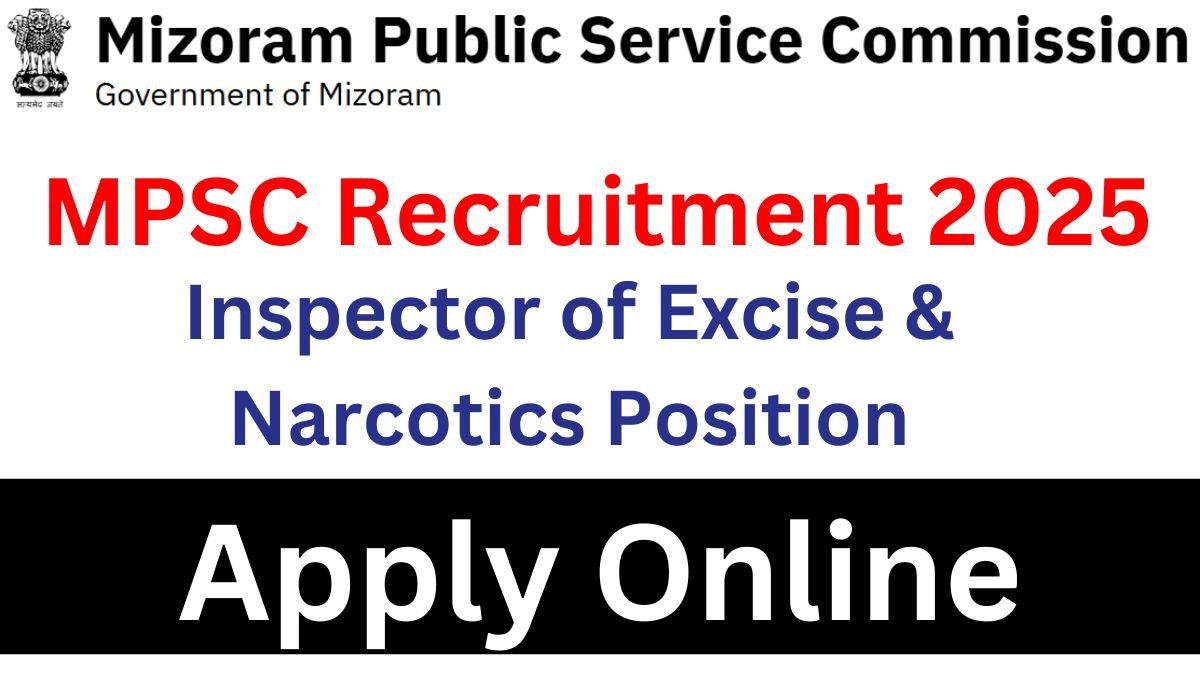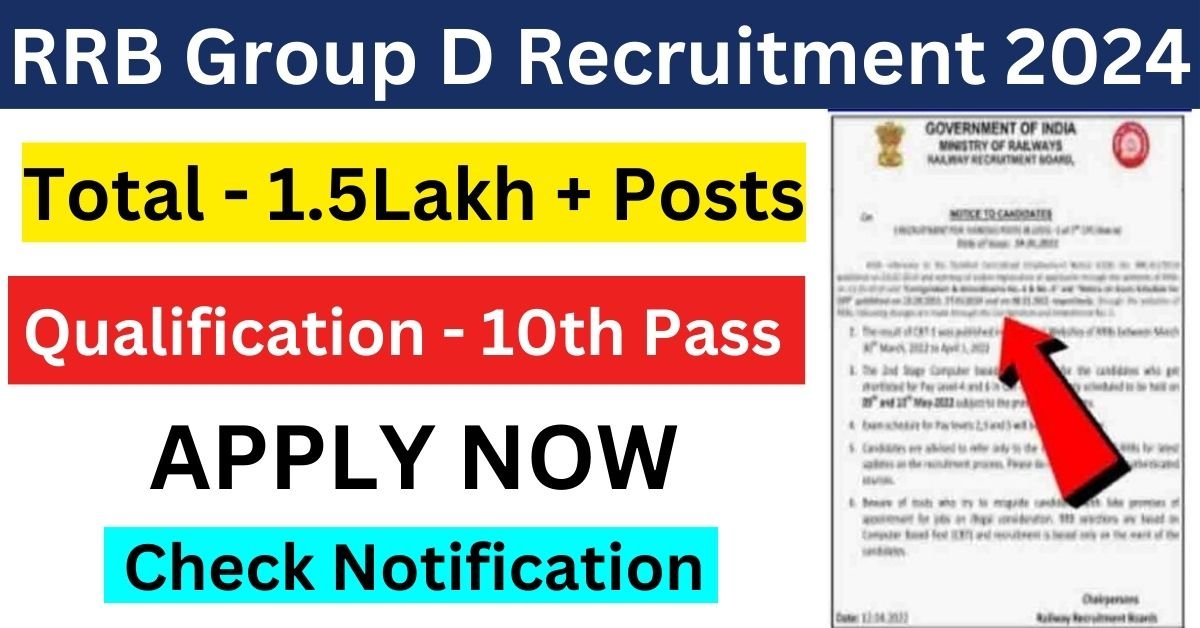MPSC Recruitment 2025 : The Mizoram Public Service Commission (MPSC) has recently issued a new vacancy notification, if you want to do a job in Inspector of Excise & Narcotics in the Excise & Narcotics Department, then read this post carefully and you can apply easily through the apply link. Interested candidates can apply for this Recruitment.
Organization Name – Mizoram Public Service Commission (MPSC).
Total Number of Vacancies – 01
Employment Type – Mizoram Govt. Job
| Organisation Name | Mizoram Public Service Commission |
| Post Name | Inspector of Excise & Narcotics in the Excise & Narcotics Department |
| Total posts | 01 Post |
| Classification | Group ‘B’ (Gazetted) (Non-Ministerial) |
| Apply Start | Allready Started |
| Application Mode | Online |
| Last Date to Apply | April 10, 2025 |
| Educational Qualification | Graduate or equivalent from a recognized university |
| Selection Process | Written Exam and Interview |
| MPSC Website | https://mpsc.gov.in/home |
MPSC Recruitment 2025 Important Information
Job Location -: Mizoram
Post Name -:
- Inspector of Excise & Narcotics in the Excise & Narcotics Department
Official Website -: https://mpsc.gov.in/home
Applying Mode -: Online
Educational Qualification and Physical Requirements:
Candidates must have passed the Post Graduation Degree or the equivalent from a recognized Board.
| Position | Vacancy |
|---|---|
| Inspector of Excise & Narcotics | 01 |
Physical measurement :
Height – 5′ 4″
Chest – Normal-34″ Expanded-36″
iii) Physical Test:
a) 100m – 15 Secs
b) 800m – 3 Mins
Mizo Language Proficiency :
A candidate must achieve a minimum score in the qualifying test of Mizo Language
Proficiency as prescribed by the Government from time to time. However, a
candidate who studied Mizo subject in Class-X standard (HSLC) or above within
Mizoram or who opted for Mizo subject as MIL outside Mizoram is exempted from
taking the qualifying test paper.
Computer Proficiency :
Computer Proficiency as prescribed by the Mizoram Group ‘A’, ‘B’ and ‘C’ posts.
Application Fees :
NIL
Salary Structure
Level 8 of the Pay Matrix
Selection Process
- Written Test
- Interview
Age Limit
Your minimum and maximum age to apply for this post is given below. Check through Official Notification
A candidate must not be less than 18 years and not more than 30 years of age on the
last date of application.
SYLLABUS :
(i) General English : 100 Marks
(ii) General Essay : 100 Marks
(iii) General Studies Paper – I : 200 Marks
(iv) General Studies Paper – II : 200 Marks
(v) General Studies Paper – III : 200 Marks
Total : 800 Marks
DETAILS OF SYLLABUS :
1) General English……………………………………………………. : 100 Marks
(a) Précis Writing …………………………………………………. : 14 Marks
(b) Letter Writing …………………………………………………. : 10 Marks
(c) Comprehension of given passages……………………… : 10 Marks
(d) Grammar : Parts of Speech ……………………………….. : 30 Marks
(e) Correct usage and Vocabularies ………………………… : 16 Marks
(f) Formation of Sentence ……………………………………… : 20 Marks
(i) Verbs
Tenses : Present/past forms, Simple/continuous forms, Perfect forms, Future time reference
(ii) Sentence Structure
Connectors Types of sentences: Affirmative/interrogative sentences, Negation,
Exclamations Types of Phrases and Clauses: finite and non-finite subordinate
clauses, noun clauses and phrases, adjective clauses and phrases,
adverb clauses and phrases
Narration (Direct and Indirect speech)
2) General Essay : 100 Marks
There shall be 2 Units in General Essay, each Unit having 4 topics.
Candidates shall be required to write essays on 2 topics, each carrying 50
marks, taking 1 topic from each Unit. Each essay shall be written in 1000 –
1200 words.
3) General Studies Paper – I : 200 Marks
The Paper shall be divided into 2 Sections. Section-I shall be MCQ carrying
100 marks and Section-II shall be conventional essay type carrying 100
marks.
Section-I shall have 50 MCQs each carrying 2 marks. There shall be 25
questions each from Unit A and B.
Section-II shall be conventional essay type with each question carrying 20
marks. Each question may contain multiple questions by sub-dividing 20
marks. Unit A & B shall have 4 questions each. A candidate shall attempt 5
questions taking at least two questions but not more than 3 from each Unit.
Unit A : History of Modern India and Indian Cultures (100 marks)
(i) Historical forces and factors which led to the British conquest of
India with special references to Bengal, Maharashtra and Sind;
Resistance of Indian powers and causes of their failure.
(ii) Evolution of British Paramountcy over princely States.
(iii) Stages of colonialism and changes in Administrative and policies.
Revenue, Judicial and Social and Educational and their linkages
with British colonial interests.
(iv) British economic policies and their impact. Commercialisation of
Agriculture, Rural Indebtedness, Growth of Agriculture Labour,
Destruction of Handicraft Industries, Drain of Wealth, Growth of
Modern Industry and Rise of a Capitalist Class. Activities of the
Christian Missions.
(v) Efforts at regeneration of Indian society- Socio-religious
movements, social, religious, political and economic ideas of the
reformers and their vision of future, nature and limitation of 19th
Century “Renaissance”, caste movements in general with specialreference to South India and Maharashtra, tribal revolts, specially in
Central and Eastern India.
(vi) Civil rebellions, Revolt of 1857, Civil Rebellions and peasant
revolts with special reference to Indigo Revolt, Deccan Riots and
Maplia Uprising.
(vii) Rise and Growth of Indian National Movement. Social basis of
Indian nationalism policies. Programme of the early nationalists and
militant nationalists, militant revolutionary group terrorists. Rise and
Growth of communalism. Emergence of Gandhiji in Indian politics
and his techniques of mass mobilisation: Non-cooperation, Civil
Disobedience and Quit India Movement; Trade Union and peasant
movements, State(s) people movements, rise and growth of Leftwing within the Congress Socialists and communists; British official response to National Movement. Attitude of the congress to Constitutional changes 1909-1935. Indian National Army Naval
Mutiny of 1946. The Partition of India and Achievement of
Freedom.
Unit B : Current events of national and international importance. (100
Marks)
4) General Studies Paper – II : 200 Marks
The Paper shall be divided into 2 Sections. Section-I shall be MCQ carrying
100 marks and Section-II shall be conventional essay type carrying 100
marks.
Section-I shall have 50 MCQs each carrying 2 marks. There shall be 20
questions from Unit A, 20 questions from Unit B and 10 questions from Unit
C.
Section-II shall be conventional essay type with each question carrying 20
marks. Each question may contain multiple questions by sub-dividing 20
marks. Unit A & B shall have 4 questions each and Unit C shall have 2
questions. A candidate shall attempt 5 questions, taking 2 questions each
from Unit A & B and 1 question from Unit C.
Unit A : Indian Polity (80 Marks)
(i) The Roots: Colonialism and nationalism in India; A general study of
modern Indian social and political thought; Raja Rammohan Roy,
Dadabhai Naoroji, Gokhale, Tilak, Sri Aurobindo, Gandhi, B.R.
Ambedkar, M.N. Roy and Nehru.
(ii) The Structure: Indian Constitution, Fundamental Rights and
Directive Principles, Union, Government; Parliament, Cabinet,
Supreme Court and Judicial Review, Indian Federalism, Centre
State relations, State Government, Role of the Governor, Panchayati
Raj
(iii) The Functioning: Class and Caste in Indian Politics, politics of
regionalism, linguism and communalism. Problems of secularization
of the policy and national integration, Political, elites, the changing
composition; Political parties and political participation; Planning
and Developmental Administration; Socio-economic changes and its
impact on Indian democracy.
Unit B : Indian Economy (80 Marks)
(i) The Indian Economy: Guiding principles of Indian economic policy
Planned growth and distributive justice – Eradication of poverty. The
institutional framework of the Indian economy. Federal
governmental structure-Agriculture and industrial sectors- Public
and private sectors. National income – its sectoral and regional
distribution. Extent and incidence of poverty.
(ii) Agriculture Production: Agriculture Policy: lands reforms,
Technological change. Relationship with the Industrial Sector.
(iii) Industrial Production: Industrial Policy, Public and private sector,
Regional distribution. Control of monopolies and monopolistic
practices.
(iv) Pricing Policies for agricultural and industrial outputs Procurement
and public Distribution.
(v) Budgetary trends and fiscal policy.
(vi) Monetary and credit trends and policy- Banking and other financial
institutions.
(vii) Foreign trade and the balance of payments.
(viii) Indian Planning: Objectives, strategy, experience and problems
Unit C : Geography of India (40 Marks)
(i) Physical Aspects – Geological history, physiography and drainage
systems, origin and mechanism of the Indian Monsoon,
identification and distribution of drought and flood prone areas;
soils and vegetation, land capability, schemes of natural
physiographic drainage and climate regionalisation.
(ii) Human Aspects – Genesis ethnic/racial diversities; tribal areas and
their problems; and role of language, religion and culture in the
formation of regions; historical perspectives and unity and diversity;
population distribution, density, and growth, population problems
and policies. Resources conservation and utilization of land mineral,
water, biotic and marine resources, man and environment-ecological
problems and their management.
(iii) Agriculture – The infrastructure, irrigation, power fertilizers, and
seeds; institutional factors, land holdings, tenure, consolidation and
land reforms; agricultural efficiency, and productivity, intensity of
cropping, crop combinations and agricultural regionalization, greenrevolution,
dry-zone agriculture, and agricultural land use policy;
food and nutrition; Rural economy, animal husbandry, social
forestry and household industry.
(iv) Industry – History of industrial development factors of localization;
study of mineral based, agro-based and forest based industries,
industrial decentralization and industrial policy; industrial
complexes and industrial regionalization, identification of backward
areas and rural industrialization.
(v) Transport and Trade – Study of the network of roadways, railways,
airways and water ways, competition and complimentarily in
regional context; passenger and commodity flow, intra and
interregional trade and the role of rural market centres.
(vi) Settlements- Rural settlement patterns; urban development in India;
Census concepts of urban areas, functional and their archaical
patterns of Indian cities, city regions and the rural-urban fringe;
internal structure of Indian cities; town planning slums and urban
housing; national urbanization policy.
(vii) Regional Development and Planning – Regional policies in Indian
Five Year Plan; experience of regional planning in India, multi-level
planning state, district and clock level planning, Centre State
relations and the Constitutional framework for multi-level planning,
Regionalisation for planning for metropolitan regions; tribal and hill
areas, drought prone areas, command areas and river basins;
regional disparities in development in India.
(viii) Political Aspects – Geographical basis of Indian federalism, state
reorganization; regional consciousness and national integration; the
international boundary of India and related issues; India and
geopolitics of the Indian Ocean area.
5) General Studies Paper – III : 200 Marks
The Paper shall be divided into 2 Sections. Section-I shall be MCQ carrying
100 marks and Section-II shall be conventional essay type carrying 100
marks.
Section-I shall have 50 MCQs each carrying 2 marks. There shall be 20
questions from Unit A, 20 questions from Unit B and 10 questions from Unit
C.
Section-II, Unit A & B shall be conventional essay type with each question
carrying 20 marks. Each question may contain multiple questions by
subdividing 20 marks. Unit A & B shall have 4 questions each, out of which a
candidate shall attempt 2 questions from each Unit. Questions from Unit C
shall be objective short answer type – one question may contain multiple
objective/short answer type questions.
Unit A : The role and impact of science and technology in the development
of India. (80 Marks)
In the part relating to the role and impact of science and
technology in the development of India, questions shall be asked to
test the candidate’s awareness of the role and impact of science
and technology in India, emphasis shall be on applied aspects. It
shall also include general knowledge relating to science, inventions
and discoveries, terminologies, etc.
Unit B : History, Cultural Heritage and Traditional Practices and General
Knowledge about Mizoram (80 Marks)
History, Cultural Heritage and Traditional Practices and General
Knowledge about Mizoram shall include broad history of Mizoram
including pre and post advent of the British, Colonial Era, the
Lushai Chiefs, Political upheavals, famines, socio-economic and
political events after independence. Cultural and traditional
practices, customary laws and practices including folk lore and
songs, dances and festivals. General Knowledge shall include
objective questions about Mizoram.
Unit C : Aptitude Test (40 Marks)
(i) Numerical And Figurework Tests: (12 Marks)
These tests are reflections of fluency with numbers and calculations.
It shows how easily a person can think with numbers. The subject
shall be given a series of numbers. His/Her task is to see how the
numbers go together to form a relationship with each other. He/She
has to choose a number which would go next in the series.
(ii) Verbal Analysis And Vocabulary Tests: (12 Marks)
These tests measure the degree of comfort and fluency with the
English language. These tests shall measure how a person will
reason with words. The subject shall be given questions with
alternative answers, that will reflect his/her command of the rule and
use of English language.
(iii) Visual And Spatial/3-D Ability Tests: (8 Marks)
These tests are used to measure perceptual speed and acuity. The
subject shall be shown pictures where he/she is asked to identify the
odd one out; or which comes next in the sequence or explores how
easily he/she can see and turn around objects in space.
(iv) Abstract Reasoning Tests: (8 Marks)
This test measures the ability to analyse information and solve
problems on a complex, thought based level. It measures a person’s
ability to quickly identify patterns, logical rules and trends in new
data, integrate this information, and apply it to solve problems.
How to Apply
Mode – Online
You can use the online medium to apply for this post.
To apply, first go to the official website. https://mpsc.gov.in/home
At the top you will see a button of MPSC Recruitment 2025. Notification which has to be clicked
An application form will appear in front of you from which you have to fill your personal details and register
After filling the form, pay the application fee through online mode and click on the submit button.
Take a print out of the failed application form which will be useful for future use.
In this way you can easily fill up the form
Important Date
Apply Start – Allready Started
Apply Last Date – April 10, 2025
Important Link -:
Notification Link 1 – Click Here
Apply Link – Click Here
Official Website – Click Here
YouTube Link – Click Here
Check More –
-
RRB Group D Recruitment 2024 – Application form, Vacancies, Eligibility Criteria – Apply For 103769 Posts
-
Match Masters Free Gifts, Spins, and Boosters July 2025
-
ICG Recruitment 2025 Apply Online for 170 Assistant Commandant Posts
-
Indian Railway Announced New Vacancies RRB Paramedical Recruitment 2025 – Apply Here




